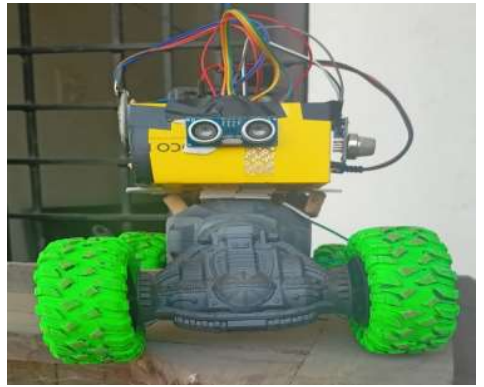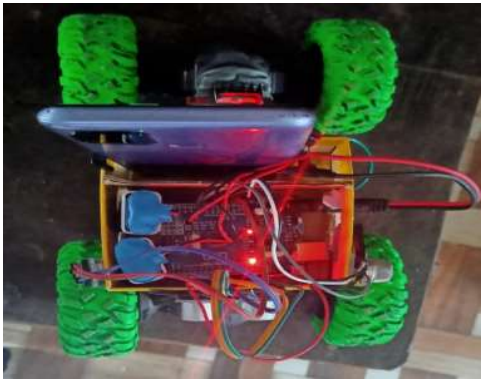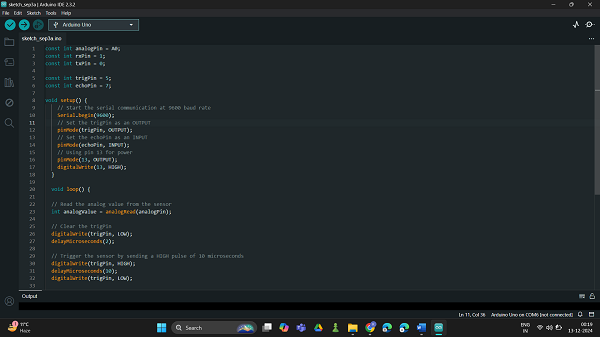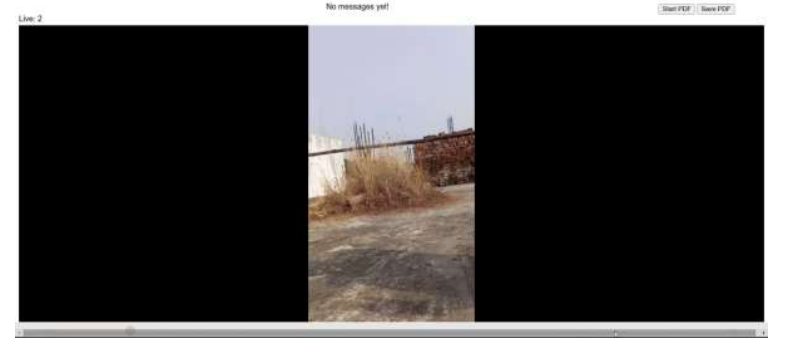Ijraset Journal For Research in Applied Science and Engineering Technology
- Home / Ijraset
- On This Page
- Abstract
- Introduction
- Conclusion
- References
- Copyright
Indri: Remote Controlled Robot for Sensing Hazardous Gases in Mines
Authors: Jitesh Kumar Sahu, Pranjal Mahapatra, K Yashwant Rao, Sparsh Verma, Eshank Sharma, Ms. Sonia Wadhwa
DOI Link: https://doi.org/10.22214/ijraset.2024.65988
Certificate: View Certificate
Abstract
\"Indri\" is a remote-controlled robot developed to improve safety in mining operations by detecting hazardous gases that pose risks to human health and safety. Using sensitive gas sensors, Indri identifies the presence of harmful gases like methane and carbon monoxide within mines environment. Operated remotely, the robot allows for real-time monitoring from a safe distance, reducing the need for human exposure to potentially dangerous conditions. Indri’s compact design enables it to navigate confined spaces, while its communication system transmits live data to a control interface, alerting users when gas levels exceed safe limits. By providing early warnings, Indri offers a proactive solution to enhance mine safety, making it a valuable tool for environmental monitoring and risk management.
Introduction
I. INTRODUCTION
Underground coal mine is characterized by tough working condition and hazardous environment.[1] Geohazards in mining are not only harmful to workers and the surrounding conditions alone but involve long-term exposure to other living ecosystems, the food chain, as well as the earth’s geology structure. These geohazards are of many different types. One such type is in the form of poisonous gases. Mining environments pose significant risks to workers due to hazardous gases such as methane, carbon monoxide, and hydrogen sulphide. These gases, often found in confined underground spaces, can lead to dangerous explosions, respiratory issues, and even fatalities. Traditional methods for detecting these gases rely on portable detectors or manual sampling, which expose workers to high-risk conditions. As the demand for safer mining practices increases, the need for remote and automated gas monitoring solutions has become more urgent.
Recent technological advancements have introduced robotic and IoT-enabled systems that can autonomously monitor environmental conditions and detect toxic gases in real time. Like many other industries, the mining industry is implementing digital transformation to achieve automation.[4] Robots equipped with gas sensors allow for the continuous monitoring of gas levels without direct human involvement, thus reducing the risk to workers. Additionally, these robots can be operated remotely, allowing for data to be collected from a safe distance. These solutions offer a significant advantage over handheld sensors by allowing miners to identify hazardous conditions early and take preventative measures.
The "Indri" project aims to address these safety challenges by creating a remote-controlled robot specifically designed for detecting and monitoring hazardous gases in mining environments. This robot combines robust sensors with a reliable communication system that enables real-time data transmission to operators. By providing early warnings of toxic gas concentrations, Indri enhances safety protocols and reduces reliance on manual gas checks, ultimately contributing to a safer, more efficient mining environment. This project aligns with global efforts to leverage robotics and IoT for safer industrial applications and highlights the growing importance of automated solutions in high-risk fields like mining.
II. LITERATURE SURVEY
Mining operations are often threatened by the presence of hazardous gases such as methane, carbon monoxide, and hydrogen sulphide, which can lead to explosions and respiratory harm. The global mining industry is facing economic concerns, such as high initial investment [5] and fluctuating commodity prices [6], extreme mining conditions, such as deeper and steeper deposits [7], severe geotechnical and geological challenges [8], such as lower ore grade [9], and a range of social and environmental issues, such as safety and diverse community responses to mining activities [10]. Some of these economic concerns can easily be taken care off by increasing the safety of mines. Traditional approaches to gas detection, such as handheld monitors, have played an essential role in worker safety, yet they require personnel to enter potentially dangerous areas to obtain measurements, thus risking exposure.
Early research on wearable gas detectors helped mitigate this risk, with devices that continuously monitor surrounding gas levels and alert users when concentrations become dangerous. Although useful, wearable detectors are limited by their range and may not adequately cover large or remote areas in complex mining tunnels.
Recent developments in sensor technology have introduced fibre optic sensors and IoT-enabled systems for hazardous gas detection, providing improved accuracy, range, and real-time monitoring. Fiber optic sensors, for instance, are lauded for their high sensitivity and resilience in harsh environments, making them effective for mining applications. IoT-based monitoring systems, such as those employing LoRa and Zigbee wireless communication, allow for remote and continuous data transmission from various points within a mine. These systems support real-time alerts, enabling pre-emptive safety measures before gases reach dangerous levels. Despite these advances, current IoT systems in mining are sometimes limited by connectivity issues in deep mines, where signal interference can obstruct reliable data transmission.
Incorporating robotics into hazardous environment monitoring has shown promising potential for further improving mines safety. Robotic systems equipped with multi-sensor setups (e.g., gas, temperature, humidity) can autonomously navigate through mine tunnels, gathering comprehensive environmental data without risking human exposure. Recent studies highlight that robots designed for such applications can endure rugged terrains and adapt to confined spaces, making them suitable for remote-controlled and autonomous applications in mines. However, challenges remain in achieving optimal robot manoeuvrability, power efficiency, and integration of real-time alert systems, which can affect operational efficiency and reliability.
While existing systems have made significant strides in advancing mine safety, certain limitations persist. IoT-enabled systems can suffer from connectivity issues in mines, impacting data reliability. Robotics systems, though capable of monitoring hazardous environments, often encounter difficulties with power management and may lack the range and durability needed for continuous, extended operation in deep mines network. Furthermore, the integration of multiple sensor types on a single robotic platform can present challenges, such as data synchronization and real-time alerting efficiency. These limitations reveal a need for further innovation in robotic systems specifically designed for extended use in mining environments.
The "Indri" project aims to address these identified gaps by integrating advanced gas sensors with a robust remote-controlled robotic platform. Unlike traditional gas detectors, "Indri" is designed to be operated remotely, reducing the need for human presence in hazardous areas and providing real-time data from deep within mines. By leveraging a highly adaptable communication system, Indri seeks to overcome the connectivity issues common in subterranean environments. This project builds upon existing research in IoT and robotics for hazardous environments, contributing a novel, integrated solution that enhances safety protocols and monitoring efficiency in mining operations.
III. PROBLEM STATEMENT
Mining is the most fundamental industry in the supply chain of resources for manufacturing, technology development and construction.[11] Fire, toxic atmospheric contaminant and dust or gas explosion are some critical hazards specifically linked to underground mining.[1] Mining operations face a significant safety challenge due to the presence of hazardous gases such as methane, carbon monoxide, and hydrogen sulphide. These gases are not only toxic but also highly explosive in confined spaces, posing severe risks to mine workers. Traditional gas detection methods, which often require miners to carry handheld detectors or use stationary monitoring equipment, expose personnel to harmful environments and have limited range and effectiveness, particularly in complex underground networks. Current IoT-enabled gas detection systems provide some improvements in real-time monitoring but are hindered by connectivity issues in deep mines, where wireless communication can be unreliable. Gas sensors detect presence of various gases within an area, usually as a part of safety system.[1] For sustainable growth of coal mining industry and safety of miners, it is necessary to develop technologies and find ways to make mines hazard free.[3]
Furthermore, while robotic systems for hazardous environment monitoring have shown potential, many existing designs lack the durability and range required for continuous operation in the rough and spatially complex conditions of underground mines. Therefore, there is a critical need for a comprehensive solution that can remotely detect hazardous gases in real-time, operate efficiently in challenging terrains, and reliably transmit data to ensure worker safety.
The "Indri" project addresses this need by developing a remote-controlled robotic system equipped with advanced sensors and a robust communication system, specifically designed to navigate and monitor gas levels in underground mining environments. By enabling remote data acquisition and alerting capabilities, this project aims to reduce the risk of human exposure to dangerous gases and enhance the overall safety and efficiency of mining operations.
IV. METHODOLOGY
A. IADDTI Methodology for Hardware Development
This project utilizes the IADDTI (Identify, Analyze, Design, Develop, Test, Implement) methodology for the hardware component and the Agile methodology for software development. These approaches together support the iterative refinement and adaptability required for a prototype model, ensuring robust hardware and responsive software for remote gas sensing in mining environments.
The IADDTI methodology provides a structured approach to the design and development of hardware systems, ensuring that each stage is validated before progressing to the next. This method is highly suited for hardware projects where components are tested incrementally to achieve optimal performance and reliability.
- Identify: The first step is to identify the requirements for the hardware components needed for remote-controlled gas sensing. This includes selecting an Arduino board, gas sensors, an ultrasonic sensor, a Bluetooth module, and other components based on functionality, compatibility, and suitability for use in a mining environment.
- Analyze: In this phase, each selected component is analyzed for its performance, accuracy, range, and limitations. For example, the gas sensor’s sensitivity and the range of the Bluetooth module are assessed to ensure they meet the data acquisition and transmission needs of the project. Limitations, such as Bluetooth range or the sensor's detection threshold, are noted for further optimization.
- Design: A blueprint of the hardware configuration is created, showing the placement of each sensor, the Bluetooth module, and the power supply on the mobile platform. The design phase considers factors such as durability, stability, and accessibility of components, ensuring that the hardware setup will be effective for navigating confined spaces.
- Develop: This stage involves assembling and integrating the hardware components on the vehicle. Each component is connected and configured based on the design, with the Arduino serving as the central control for data collection and transmission.
- Test: The assembled hardware is tested in controlled environments to verify that it meets the project’s functional and performance requirements. Each sensor’s accuracy is evaluated, and the Bluetooth communication is tested for stability over various distances. The prototype is refined based on these tests to resolve issues and improve reliability.
- Implement: After successful testing, the hardware is implemented as a fully functional prototype. This implementation phase includes preparing the vehicle for operation in real-world conditions similar to those in mining environments. The IADDTI methodology ensures that all components are thoroughly vetted, reducing the chances of hardware failure in testing environments.
B. Agile Methodology for Software Development
The Agile methodology is used for the software component, offering a flexible and iterative approach that is well-suited to managing the project’s complexities, such as data processing, remote communication, and real-time monitoring.
- Sprint Planning and Requirements Analysis: Each sprint begins with a planning session to define the goals and requirements of specific software features, such as sensor data processing, Bluetooth communication, or integration with the video call feed. Agile’s flexibility allows for adjustments based on the prototype’s evolving needs.
- Incremental Development: The software is developed in iterations, with each sprint producing a functional increment. For example, one sprint may focus on developing a module for gas sensor data processing, while another focuses on Bluetooth data transmission to the smartphone. This incremental approach allows each component to be developed, tested, and refined separately.
- Continuous Testing and Feedback: Throughout the development process, the software undergoes regular testing to identify and resolve issues early. Each module, such as sensor data acquisition or real-time monitoring, is tested independently before integration. Feedback from each sprint informs the adjustments needed in subsequent sprints, allowing for continuous improvement.
- Integration and Deployment: Once the individual components are tested, they are integrated into a complete system that enables the vehicle’s control and data transmission to the remote monitoring station. The integrated software is then deployed to the smartphone on the vehicle, where it processes and transmits data, allowing for final testing of the overall functionality and user interface.
- Review and Retrospective: After each sprint, the team conducts a review and retrospective to assess the effectiveness of the software, identify challenges, and determine any additional improvements. Agile’s iterative nature allows for consistent refinement and adaptability, which is essential for managing connectivity limitations and data transmission challenges.
V. SYSTEM HARDWARE SPECIFICATIONS
The hardware system for this prototype includes a combination of components designed to detect hazardous gases, enable navigation, and facilitate remote data transmission. Below are the specific components and their roles within the system:

Fig. 1 Robot Body

Fig. 2 Trailer Setup with Sensors and Batteries
- Vehicle Platform: A remote-controlled vehicle serves as the mobile platform for housing the sensors and communication modules. This platform supports the movement of the entire setup within a mining environment. It is controlled remotely via a radio transmitter and receiver, allowing it to navigate within the range limitations of radio frequency.
- Arduino Microcontroller: An Arduino board serves as the central microcontroller for the system, managing sensor data acquisition and initial data processing. It is responsible for reading data from the gas and ultrasonic sensors, organizing the data, and then sending it via Bluetooth to a connected smartphone.
- Gas Sensor: The gas sensor (e.g., MQ-2 or a similar model) is installed to detect hazardous gases like methane and carbon monoxide. It continuously monitors the surrounding air and provides real-time readings on gas concentration levels to the Arduino board.
- Ultrasonic Sensor: The ultrasonic sensor is included for obstacle detection, assisting in safe navigation of the vehicle through confined spaces. It measures distances to nearby objects, allowing the vehicle to avoid collisions.
- Bluetooth Module: The Bluetooth module (e.g., HC-05 or HC-06) connects the Arduino to the smartphone on the vehicle. It transmits sensor data from the Arduino to the smartphone for further processing, enabling wireless, short-range data communication.
- Smart-phone: A smartphone mounted on the vehicle acts as a processing and transmission unit. It receives data from the Arduino via Bluetooth, processes the data, and transmits it to the remote-control station using internet-based video calling. This setup allows for both video feedback and sensor data to be streamed in real time.
- Radio Wave Transmitter and Receiver: A basic radio frequency (RF) transmitter-receiver pair is used to remotely control the vehicle. While the range of RF control is limited, it allows for straightforward remote manoeuvring within the effective range of the transmitter.
- Power Supply: Batteries power the Arduino, sensors, and communication modules, enabling mobility without dependency on external power sources. Battery capacity is chosen based on the estimated power consumption for short-term operation, given that this is a prototype model.
VI. SOFTWARE SPECIFICATIONS
The software system for the "Indri" prototype is designed to process sensor data, manage communication between hardware and remote systems, and enable real-time control of the vehicle. It is divided into two main parts: software on the vehicle's smartphone, which handles data processing and communication, and a control application at the remote station, which manages video feeds and sensor data display.

Fig. 3 Arduino Code
The smartphone software acquires sensor data from the Arduino via Bluetooth, with the Arduino connected to gas and ultrasonic sensors. This data is monitored in real-time, validated to filter out noise or errors, and aggregated into a unified format. The processed data is logged locally for post-analysis and transmitted to the remote monitoring system. The smartphone also handles internet communication, sending the processed data and a video feed to the remote station using video call platforms like Zoom or Google Meet. WebRTC or similar technologies ensure a stable connection for real-time communication, allowing the remote operator to view the vehicle’s surroundings and access up-to-date sensor data.

Fig. 4 Mobile Application
At the remote station, the software provides a real-time video feed of the vehicle's environment, which helps operators navigate challenging terrains and monitor hazardous gas levels. A user interface enables the operator to control the vehicle's movement via a radio transmitter and displays sensor readings in a visually intuitive format, including graphs and charts. Alerts are triggered when gas concentrations exceed predefined safety thresholds, ensuring timely notifications about potential dangers.

Fig. 5 Remote Station Application
Data logging and historical analysis are integral to the system. All sensor data is stored on the smartphone with timestamps in a local database, such as SQLite, and can be exported for further analysis. The software facilitates post-processing, enabling the generation of performance reports and graphs to assess sensor reliability and overall system efficiency.
The software architecture incorporates multiple technologies for an efficient, interactive experience. The Arduino IDE is used to manage sensor data collection and vehicle control. The smartphone app, developed using Android Studio in Java or Kotlin, processes the sensor data, manages the video feed, and communicates with a backend built on Node.js and Express. The remote station application is built using Vite and ReactJS, providing a responsive interface for control and data display. Firebase is employed for real-time data logging, ensuring immediate availability of sensor data across the system. The Stream API supports video streaming, enabling continuous visual feedback for remote operation.
The integration of these components results in a robust system that supports real-time communication, remote control, and sensor data monitoring, providing critical capabilities for hazardous gas detection and mine-safety.
VII. LIMITATIONS AND FUTURE SCOPE
While the "Indri" prototype demonstrates the potential for using remote-controlled robots in hazardous environments like mines, several limitations exist that could impact its practical deployment. These limitations arise from both the hardware and software components, as well as environmental factors. Below are the key limitations:
- Limited Communication Range: The primary mode of communication between the vehicle and the remote-control station is through radio waves, which are subject to range limitations. The distance over which the radio transmitter and receiver can communicate is constrained by the power of the transmission and environmental factors like obstacles or interference. This restricts the operational range of the vehicle, especially in larger or more complex mine structures.
- Dependency on Internet Connectivity: The remote monitoring and video streaming depend on internet connectivity. In underground environments or areas with poor network coverage, internet access may be unreliable or unavailable, which can disrupt the video feed or prevent real-time communication with the control station. This is a significant concern for deployment in remote or underground mining environments, where reliable internet connections may not always be accessible.
- Bluetooth Communication Limitations: The Bluetooth module used for communication between the Arduino board and the smartphone has a limited range, typically up to 100 meters in open space. In a confined mining environment with walls or obstructions, this range could be reduced further, limiting the ability of the smartphone to receive sensor data or send control commands effectively.
- Sensor Accuracy and Reliability: The gas sensor used in the prototype, while effective for detecting hazardous gases, may have limitations in terms of accuracy and response time. Environmental factors such as temperature, humidity, and the presence of other gases can affect sensor readings, leading to potential false positives or inaccurate readings. Additionally, ultrasonic sensors for obstacle detection may face challenges in environments with irregular surfaces or highly reflective materials, potentially impacting navigation accuracy.
- Power Supply Constraints: The vehicle and its components are powered by batteries, which limit the operational duration. In demanding environments like mines, where continuous operation may be required for extended periods, the battery life could be insufficient, requiring frequent recharging or battery swaps. Additionally, the power consumption of sensors, communication modules, and the smartphone adds to the overall energy demand, further limiting operational time.
- System Stability and Performance: As a prototype, the system is still subject to bugs, performance issues, and reliability concerns, especially in terms of software stability and integration. Delays in data processing, occasional disconnections, or lag in video streaming can disrupt the system’s overall performance and user experience, limiting its effectiveness in critical applications.
- Cost and Scalability: While the prototype uses off-the-shelf components such as smartphones, Arduino boards, and sensors, the scalability of the system for large-scale deployment in real-world mining operations could be hindered by the cost of these components. Moreover, integrating more robust communication systems (e.g., long-range wireless protocols, dedicated networks) would add to the overall cost, making it less feasible for mass adoption without additional funding or support.
Other limitations and future scopes of this project may include the surveillance capabilities of this project. These are applications that are not directly a benefit of our project but can be seen as a benefit indirectly. To facilitate proper design of a ventilation system for underground mine, it is necessary to develop in-depth knowledge of the airflow patterns and gases dispersion.[2]
Conclusion
In conclusion, the \"Indri\" prototype represents a significant step toward enhancing safety in mining environments through the use of remote-controlled robotic systems. By integrating gas sensors, real-time data transmission, and remote-control capabilities, the system addresses critical challenges posed by hazardous gases, offering an alternative to traditional, risk-prone detection methods. Despite its limitations, such as restricted communication range, dependency on stable internet connectivity, and power constraints, the prototype demonstrates the potential of robotics and IoT in industrial applications. Future improvements, such as extending the communication range, improving sensor accuracy, and optimizing energy efficiency, could make the system more robust and scalable for real-world deployment. The project\'s emphasis on early detection and continuous monitoring highlights the importance of proactive safety measures in high-risk environments. As the demand for automated solutions grows, the \"Indri\" prototype underscores the value of integrating advanced technologies to safeguard workers and reduce operational hazards, paving the way for safer and more efficient mining practices.
References
[1] A. Kumar, T.M.G. Kingson, R.P. Verma, A. Kumar, R. Mandal, S. Dutta, S.K. Chaulya and G.M. Prasad, “Application of Gas Monitoring Sensors in Underground Coal Mines and Hazardous Areas”, International Journal of Computer Technology and Electronics Engineering (IJCTEE), vol. 3, pp.9-23, Issue 3, June 2013 [2] Jundika C. Kurnia, Agus P. Sasmito, Wai Yap Wong, Arun S. Mujumdar, “Prediction and innovative control strategies for oxygen and hazardous gases from diesel emission in underground mines, Science of The Total Environment,” vol. 481, pp. 317-334, 2014 [3] S. R. Raheem “Remote monitoring of safe and risky regions of toxic gases in underground mines: a preventive safety measures,” In: Postgraduate Diploma thesis report, African Institute for Mathematical Sciences (AIMS), South Africa, 2011 [Online] Available: http://users.aims.ac.za/~soliu/soliu.pdf [4] H. Zhang, B. Li, M. Karimi, S. Saydam and M. Hassan, \"Recent Advancements in IoT Implementation for Environmental, Safety, and Production Monitoring in Underground Mines,\" in IEEE Internet of Things Journal, vol. 10, no. 16, pp. 14507-14526, 15 Aug.15, 2023 [5] H. Nourali and M. Osanloo, \"A regression-tree-based model for mining capital cost estimation\", Int. J. Min. Reclamat. Environ., vol. 34, no. 2, pp. 88-100, 2020. [6] J. E. Tilton and J. I. Guzmán, Mineral Economics and Policy, New York, NY, USA:Routledge, 2016. [7] J.-G. Li and K. Zhan, \"Intelligent mining technology for an underground metal mine based on unmanned equipment\", Engineering, vol. 4, no. 3, pp. 381-391, 2018. [8] D. P. Adhikary and H. Guo, \"Measurement of longwall mining induced strata permeability\", Geotech. Geol. Eng., vol. 32, no. 3, pp. 617-626, 2014. [9] S. Northey, S. Mohr, G. M. Mudd, Z. Weng and D. Giurco, \"Modelling future copper ore grade decline based on a detailed assessment of copper resources and mining\", Resource Conserv. Recycling, vol. 83, pp. 190-201, Feb. 2014. [10] K. Spitz and J. Trudinger, Mining and the Environment: from Ore to Metal, London, U.K.: CRC Press, 2019. [11] Fatemeh Molaei, Elham Rahimi, Hossein Siavoshi, Setareh Ghaychi Afrouz, Victor Tenorio. “A Comprehensive Review on Internet of Things (IoT) and its Implications in the Mining Industry.” American Journal of Engineering and Applied Sciences, 2020, 13 (3), pp.499-515.
Copyright
Copyright © 2024 Jitesh Kumar Sahu, Pranjal Mahapatra, K Yashwant Rao, Sparsh Verma, Eshank Sharma, Ms. Sonia Wadhwa. This is an open access article distributed under the Creative Commons Attribution License, which permits unrestricted use, distribution, and reproduction in any medium, provided the original work is properly cited.

Download Paper
Paper Id : IJRASET65988
Publish Date : 2024-12-18
ISSN : 2321-9653
Publisher Name : IJRASET
DOI Link : Click Here
 Submit Paper Online
Submit Paper Online

